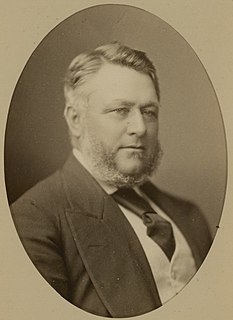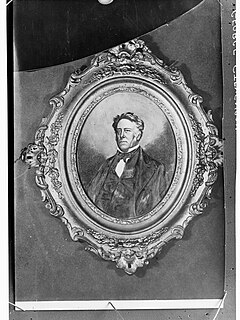Related Research Articles

Sir Henry Ayers was the eighth Premier of South Australia, serving a record five times between 1863 and 1873.

The Register, originally the South Australian Gazette and Colonial Register, and later South Australian Register, was South Australia's first newspaper. It was first published in London in June 1836, moved to Adelaide in 1837, and folded into The Advertiser almost a century later in February 1931.

Matthew Moorhouse was an English pioneer in Australia, pastoralist, politician, and Protector of Aborigines in South Australia. He was in charge of the armed party that murdered 30-40 Maraura people, which may have included women and children, now known as the Rufus River massacre.

George Stevenson was a pioneer South Australian newspaper editor and horticulturist. He came to Adelaide as private secretary to the first Governor of South Australia, John Hindmarsh.

Alexander Tolmer was a South Australian police officer and Police Commissioner. He was educated at Plymouth, Rouen, Maidstone and Hawkhurst. He migrated to South Australia in 1840 where he was made sub-inspector by Governor George Gawler.

Robert Cock was one of the first European explorers of the Adelaide region of South Australia following the establishment of the colony in December 1836.
The South Australian was a newspaper published in Adelaide, the capital of colonial South Australia from 2 June 1838 to 19 August 1851. Between 1838 and 1844, it was published as The Southern Australian.
John Stephens was a writer, polemicist and editor in England who became an editor and newspaper owner in the early days of South Australia.

Thomas Greaves Waterhouse JP was a prominent businessman, investor and philanthropist in early colonial South Australia arriving soon after the start of official settlement. He was one of the early shareholders of the Burra Burra Mine, and for a long time held a seat on the Directorate. He was also involved in the establishment of the Bank of Adelaide.
The Observer, previously The Adelaide Observer, was a Saturday newspaper published in Adelaide, South Australia from July 1843 to February 1931. Virtually every issue of the newspaper has been digitised and is available online through the National Library of Australia's Trove archive service.
South Australian Mining Association was a no-liability company which established several mines in South Australia, notably the "Grey Wheal", or north mine at Burra, which made a fortune for its promoters, the "Snobs", while the adjacent southern claim, by the Princess Royal Company ("Nobs") proved worthless.
The Australische Zeitung was a weekly German-language newspaper published in Tanunda, South Australia from 1860 until it ceased publication during World War I in 1916 due to anti-German sentiment. The newspaper also existed in a variety of earlier names or merged publications, reflecting the fluid nature of the newspaper industry in Victorian gold rush era colonial South Australia. The long history of German language Australian newspapers reflects the considerable German-speaking population which settled in South Australia in the nineteenth century.

Harriet Clisby was an English physician, women's rights activist, and founder of the Women's Educational and Industrial Union in Boston.
Lieutenant George Frederick Dashwood RN, frequently referred to as "Captain Dashwood", was a naval officer, public servant and politician in South Australia. He was appointed an acting member of the Legislative Council of South Australia, serving from June 1843 to June 1844.
Jacob Hagen was a businessman involved in many business ventures in the colony of South Australia. He served in the Legislative Council from September 1843 to February 1851.
The Adelaide Chronicle was an early publication in Adelaide, the capital of the then colony of South Australia. It was published between 1839 and 1842, when it ceased publication as a result of the economic depression caused by the mass exodus of workers to the Victorian goldfields.
The Pictorial Australian was a monthly illustrated paper published in South Australia by the Frearson Brothers, Samuel and Septimus, who were printers located on King William Street and Grenfell Street, Adelaide. The publication evolved over time, both in terms of name, publication frequency, and content.
The Adelaide Times was an early newspaper founded by James Allen and printed in Adelaide, the capital of the then colony of South Australia. It was published between 2 October 1848 and 8 May 1858, and evolved through a series of names and publication frequencies, and closed due to uncertainty surrounding Allen's bankruptcy.
The South Australian Colonist, full name The South Australian Colonist and Settlers' Weekly Record of British, Foreign and Colonial Intelligence, was a weekly newspaper published in London between March and September 1840.
References
- ↑ Laube, Anthony. "LibGuides: SA Newspapers: S". guides.slsa.sa.gov.au. Retrieved 31 March 2018.
- ↑ "South Australian Gazette And Colonial Register". South Australian Gazette And Colonial Register. I (1). South Australia. 5 July 1845. p. 1. Retrieved 31 March 2018– via National Library of Australia.
- ↑ "South Australian Gazette And Colonial Register". South Australian Gazette And Colonial Register. III (118). South Australia. 2 October 1847. p. 1. Retrieved 31 March 2018– via National Library of Australia.
- ↑ "South Australian Gazette and Mining Journal". South Australian Gazette and Mining Journal. III (119). South Australia. 9 October 1847. p. 1. Retrieved 31 March 2018– via National Library of Australia.
- ↑ "South Australian Gazette and Mining Journal (Adelaide, SA : 1847 - 1852)". Trove. Retrieved 31 March 2018.
- ↑ South Australian gazette and mining journal [newspaper: microform]. Adelaide, S. Aust: George Stevenson. 1847.